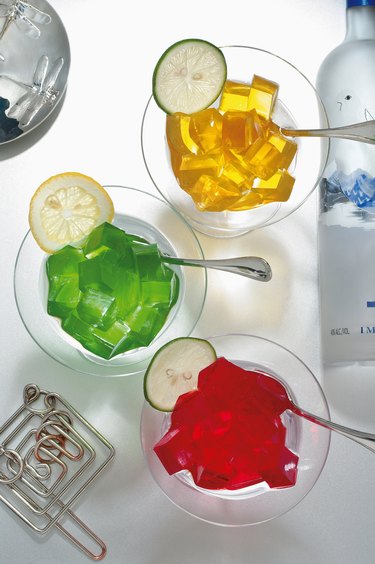
Growing muscle not only requires the right exercise but the right food too. Unfortunately, there's no one food -- gelatin included -- that's going to help your muscles grow. But as a source of protein, gelatin can be part of your diet plan. Consult your doctor or dietitian to help you design a muscle-growing diet plan that fits your exact needs.
Gelatin Nutrition
Video of the Day
Gelatin comes from the collagen found in the skin, bones and connective tissue of animals. Porkskin is the primary source of the gelatin you eat. As a derivative of collagen, gelatin is a protein food. One tablespoon of dried, unsweetened gelatin powder has 23 calories and 6 grams of protein. Gelatin is not a complete source of protein, however. It does not contain all of the essential amino acids in adequate amounts. More specifically, gelatin does not contain the essential amino acid tryptophan or enough methionine to make it complete.
Video of the Day
Gelatin and Muscle Growth
Protein is essential for muscle growth. While gelatin is a source of protein, as an incomplete protein, it alone is not sufficient enough to promote muscle growth. If you're using gelatin to help you build muscle, you need to include other food sources of protein in your diet, such as animal meat, dairy foods, beans, grains, soy foods or vegetables, to get all the essential amino acids your body needs to grow muscle. You do not need to eat any of these other sources of protein at the same time as the gelatin but within a 24-hour period, says Columbia Health.
The Importance of Balance
While protein is necessary for muscle growth, getting more in your diet isn't going to matter if you're not eating enough carbs and fat. Carbs and fat act as sources of energy, which spares your body from using the protein you eat, or even your muscle, for energy. While gelatin can increase your protein intake a bit, include carbs, such as fruit, vegetables and whole grains, and healthy sources of fat, such as oil, nuts and fatty fish, to balance your intake for better muscle growth.
Tips and Suggestions
Unsweetened gelatin has no flavor, so you can easily add it to various foods to boost protein content. For example, you can mix a tablespoon in your morning hot cereal or afternoon yogurt snack. It can also be added to your post-workout smoothie. If you're yearning for something sweet, you can use the unsweetened gelatin to make a fat-free dessert with 100 percent fruit juice, which you can whip with an egg beater after it has chilled and set to alter the consistency and make it a fluffy dessert.
- Gelatin Manufacturers Institute of America: Gelatin Manual
- Dr. Bernard Cole: Gelatin
- HealthAliciousNess.com: Nutrition Facts Comparison Tool: Gelatins Dry Powder Unsweetened
- Academy of Nutrition and Dietetics: Strength Building and Muscle Mass
- Columbia Health: Complete and Incomplete Proteins in Grains and Vegetables
- Knox Gelatine: Knox Basics